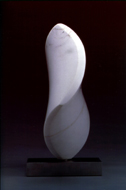“Bursting onto the scene” may be an apt description of Allan Sieradski’s emergence in the realm of stone sculpture, and “quick learner” fits him well. In three short years, he has drawn upon previously developed skills and knowledge, received some training, and conscientiously applied himself to become a very prolific and talented carver. The following interview portrays this fascinating transformation.
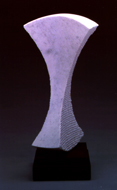
LE: Who are you?
AS: I am husband of one (wife, Karen) and father of two (sons, Matthew and Damian), mathematics professor emeritus, a stone sculptor, a woodworker, a free-heel skier, a racquetball enthusiast, and a poker player. I retired from the University of Oregon in March 2000 after 33 years in the Department of Mathematics.
LE: What is your life history as it relates to being an artist?
AS: I really haven’t been able to consider myself an artist. From youth, I was encouraged and trained to use my head for employment. But I have always felt compelled to use my hands in making things for personal expression. I have used wood in making boats, furniture, and home; and I have used metal in sculpture and furniture. Currently, this compulsion is driving me to sculpt stone.
LE: Why did you become an artist?
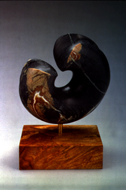 AS: If I may change the word “artist” to “stone sculptor,” the answer is to escape the bits-bytes, ROM-RAM, and virtual-vapor nonsense associated with writing mathematical textbooks using computerized tools. When I retired, I turned to the most permanent and solid form of expression that I could find: stone carving.
AS: If I may change the word “artist” to “stone sculptor,” the answer is to escape the bits-bytes, ROM-RAM, and virtual-vapor nonsense associated with writing mathematical textbooks using computerized tools. When I retired, I turned to the most permanent and solid form of expression that I could find: stone carving.
LE: How did you begin to learn stone carving?
AS: In the summers of 2000 and 2001, I attended three of the Marble/marble workshops conducted in Marble, CO by the Marble Institute of Colorado (www.marbleinst.org). They provided a good introduction to the use of power tools and the special character of Colorado Yule marble. Convinced that I might learn more by watching, I dovetailed those carving workshops with non-carving visits to the NWSSA’s Silver Falls Symposia in 2000 and 2001 and the NWSSA’s Camp Brotherhood Symposia in 2001 and 2002.
LE: How does your art reflect your philosophy?
AS: Well, I minored in philosophy in college, but I don’t know that I have acquired one yet. My wife and I raised our two sons dogma-free, and now in their mid-twenties they seem to be Taoists and Buddhists, neither baptized nor confirmed, but committed I guess. So if I find time to think about getting a philosophy, I’ll probably follow in their footsteps. But would I then have to conclude that stone is not really that solid nor very permanent after all? This is just one more reason why I don’t like to think about that stuff.
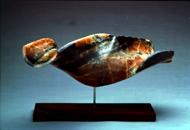
LE: Describe your art in your own terms—focusing on your stone carving.
AS: My intention is to create simple, yet essential, forms that engage and calm viewers. I try to partition the form’s surface into distinct regions whose shapes are so smooth that each can be evolved from any of its portions, and I try to make the complete form regulate the assembly of these smooth regions along crisp shared edges. This is a weak version of the holographic principle in eastern medicine and thought: the whole in every part and the parts organized by the whole.
From birth, we categorize patterns and shapes for survival and meaning. We become skillful at predicting entire forms from partial views; we are reassured when our expectations are confirmed, unsettled otherwise. And we are also continually challenged to analyze new structures. Enjoyment of sculpture involves both of these aspects of shape recognition, I believe. So I try to use smooth regions, with their inevitable contours, to reassure the viewer’s gut, and to assemble them so as to engage the viewer’s head.
LE: Is your sculpture representational and/or non-representational? What is the source of inspiration of your forms—language or imagery?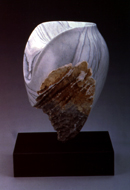
AS: Most of my carvings are non-representational, although in each I try to capture the result of a force acting on a malleable material, to stretch, tug, tear, pull, fracture, or deform it in some manner. My hope is that the form acquires an interesting dynamic quality, whether or not the viewer conceptualizes the imagined force.
LE: How do you develop your ideas (by direct carving, drawing, modeling, etc.)?
AS: After getting a mental image to fit a particular stone, or vice versa, I make a crude sketch of the form and the carving techniques it requires. Instead of refining and testing the form with a model, I prefer to start the direct carving. What follows usually is a blend of these two extremes: The carving is a free-form sequence of choices, akin to climbing up the branches of a tree of possibilities, with a choice at each junction, but no option of backing down. Or the carving is a pre-planned operation, possibly incorporating jigs and big tools, with a pre-determined goal. The former is meditation; the latter is business.
LE: What are you trying to express? What is the major theme or intent of your art?
AS: I try to achieve a coherent whole using parts that produce some natural flow or circulation. My intent is not to challenge, puzzle or educate, but rather to relax, refresh, and recharge the viewer.
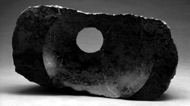
LE: Describe your work area set up and your working process.
AS: A corrugated polycarbonate roof over a 5’x 8’x 9’ warehouse shelving unit on the concrete pad outside my woodworking shop serves as my carving alcove. To control the stone dust and maintain neighborly relations, I use a curtain of silver tarp, a shop vacuum, and a 30” fan with electrostatic filters. The 5’x 8’ floor space is partitioned this way: a 5’x 3’ vacuum area, a 5’ x 2’ passageway, and a 5’x 3’ workbench. I use a 1-ton chain hoist and a rolling crossbeam supported by the shelving unit to maneuver heavier stones from the passageway onto the workbench. And I often place the stone on a turntable in order to access all its sides. Since my carving space is so limited, I usually work a single piece to completion.
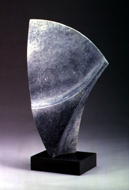
LE: What stones do you prefer?
AS: I have carved soapstone, chlorite, alabaster, anhydrite, marble, dolomite, and granite. But my tools and ability keep me in the middle of that hardness range. I like the look of fractured granite and would love to learn how to carve and not just grind that stuff.
LE: What tools do you use?
AS: I use the standard power tools: diamond blades, sanding pads, and cup-wheels on angle grinders, silicon carbide tipped chisels in a 3/4 inch and a bantam air hammer, and silicon carbide and diamond bits in die grinders. Occasionally, I control these tools using jigs that incorporate threaded rods, sleeve bearings, shafts, pendulums, turntables, lathes, and even a war-surplus X-ray stand. Some of these jigs served as a crutch until I gained confidence in my tool usage; others I’ll use again to achieve precise results on specific regions.
LE: Describe a recent piece or two. What do you like about them? What was involved in creating them?
AS: ‘Sphereless’ arose from the image of a cube squeezed by a tight waist-belt. Its surface is composed of six smooth four-edged regions, which meet as do the faces of a cube. The four concave hemispherical regions were carved using a pendulum jig, excavating portions of four spheres; the top and bottom convex hemispherical regions were shaped using a cup-wheel. I’m especially fond of this piece, because its slender waist disguises its cubic past so well.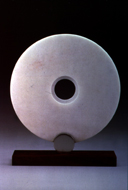
‘Confluence’ arose from this mental exercise: Mold a thick, horizontal, square, rubber sheet by pulling together one pair of diagonally opposite corners upwards, while pulling together the other pair downwards. The carvings’ surface, composed of just three regions (corresponding to the two sides of the rubber sheet and its perimeter thickness) that meet along three edges, achieves simplicity. And the curved shapes inherited by these three regions capture the dynamics of the construction. I trimmed the sculpture to an egg shape. This is a pre-planned carving but didn’t involve the use of jigs for tool control.
LE: Do you work part, or full-time as an artist?
AS: My jobless status enables me to carve for as many hours a day as my body and other interests allow. I just checked my carving list and see that I’ve completed 39 pieces in three years, essentially, one a month. When I am not distracted, I seem to get a rough carving done in a week, followed by a week of finishing, reshaping, refinishing, and basing. Apparently, I just sit around the other half of each month contemplating my completed pieces.
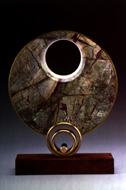
LE: Where do you exhibit your work?
AS: Thanks to Tom Urban, I had an exhibit at the Axis Gallery in Florence, Oregon for June and July of 2002 that led to the sale of five sculptures. I have exhibited at several NWSSA events: Camp Brotherhood Art Walks and the Oregon City show organized by Dave Haslett this May, which generated a sale. In February, the Freed Gallery in Lincoln City, Oregon, accepted a dozen of my sculptures and has made at least one sale to date.
Finally, I just want to say: I appreciate this opportunity to share my work and assess my progress. This self-examination, while painful, has given me a chance to clarify my approach and formulate new goals. Thanks also to the gentle critiques and warm encouragement offered by NWSSA members Tom Urban, Stu Jacobson, Dan Michael, and Rich Hestekind.